中国组织工程研究 ›› 2025, Vol. 29 ›› Issue (12): 2590-2604.doi: 10.12307/2025.372
• 组织构建循证医学 evidence-based medicine in tissue construction • 上一篇 下一篇
低容量高强度间歇训练对肥胖或超重人群心血管疾病风险因子影响的Meta分析
李秀鹏1,苏玉莹1,2,王悦同3,彭 亮1,王艺达4,荆 雯1
- 1渤海大学体育学院,辽宁省锦州市 121013;北京体育大学,2体能训练学院,3教育学院,北京市 100086;4大连理工大学体育与健康学院,辽宁省大连市 116024
-
收稿日期:2024-04-18接受日期:2024-05-23出版日期:2025-04-28发布日期:2024-09-11 -
通讯作者:苏玉莹,博士,渤海大学体育学院教师,渤海大学体育学院,辽宁省锦州市 121013;北京体育大学体能训练学院,北京市 100086 -
作者简介:李秀鹏,男,2002年生,辽宁省丹东市人,满族,主要从事体能训练与运动促进健康研究。 -
基金资助:辽宁省教育厅基本科研项目-青年项目(LJKQR20222558),项目负责人:苏玉莹;国家社会科学基金-一般项目(22BTY080),项目负责人:荆雯
Effect of low-volume high-intensity interval training on cardiovascular risk factor in obese or overweight populations: a Meta-analysis
Li Xiupeng1, Su Yuying1, 2, Wang Yuetong3, Peng Liang1, Wang Yida4, Jing Wen1
- 1School of Physical Education, Bohai University, Jinzhou 121013, Liaoning Province, China; 2School of Physical Training, 3School of Education, Beijing Sport University, Beijing 100086, China; 4College of Physical Education and Health, Dalian University of Technology, Dalian 116024, Liaoning Province, China
-
Received:2024-04-18Accepted:2024-05-23Online:2025-04-28Published:2024-09-11 -
Contact:Su Yuying, PhD, School of Physical Education, Bohai University, Jinzhou 121013, Liaoning Province, China; School of Physical Training, Beijing Sport University, Beijing 100086, China -
About author:Li Xiupeng, School of Physical Education, Bohai University, Jinzhou 121013, Liaoning Province, China -
Supported by:Liaoning Provincial Department of Education Basic Research Project - Youth Project, No. LJKQR20222558 (to SYY); National Social Science Foundation of China - General Program, No. 22BTY080 (to JW)
摘要:
文题释义:
低容量高强度间歇训练:指负荷强度保持在80%-100%最大摄氧量或最大心率之间,且在两次练习之间安排低强度的恢复性练习,全部高强度运动时间≤ 15 min。相比于传统高强度间歇训练,其最大特点是全部高强度运动时间较短。
心血管疾病:是指由心脏和血管疾患所引起的慢性疾病,包括冠心病、脑血管疾病及周围末梢动脉血管疾病等,在全球疾病死因中位居首位,其中不健康的饮食、年龄增长和缺乏身体活动是患病的重要因素。
目的:通过Meta分析综合定量评价低容量高强度间歇训练对预防肥胖或超重人群心血管疾病的效果,进一步验证低容量高强度间歇训练在肥胖等特殊人群中应用的可行性。
方法:在中国知网、PubMed、Web of Science、Cochrane Library和EBSCO-SPORTD运动科学全文数据库检索关于低容量高强度间歇训练相关研究的随机对照试验文献,检索时限为各数据库建库至2024年2月。由2名研究人员对所纳入的研究进行筛选、质量评价和数据提取,采用RevMan 5.4和Stata 17.0软件对结局指标进行Meta分析,包括合并效应量、亚组分析、Leave-One-Out敏感性分析以及发表Egger检验和绘制漏斗图。该方案已在国际系统综述前瞻性注册中心注册(CRD42024534409)。
结果:①最终筛选纳入符合要求的13项随机对照试验,共包含349例受试者,纳入文献整体质量较高。②低容量高强度间歇训练干预对心肺适能(SMD=-0.65,95%CI:-0.87至-0.43,P < 0.05)、收缩压(SMD=0.38,95%CI:0.11-0.65,P < 0.05)、舒张压(SMD=0.42,95%CI:
0.15-0.68,P < 0.05)和体脂百分比(SMD=0.25,95%CI:0.02-0.49,P < 0.05)4项指标具有改善效果。③低容量高强度间歇训练与中等强度持续训练相比在改善超重或肥胖人群心肺适能、收缩压、舒张压、体脂百分比、标准体质量、体质量指数、高密度脂蛋白、低密度脂蛋白和总胆固醇指标方面干预效果相似(P > 0.05),但在改善三酰甘油效果方面中等强度持续训练优于低容量高强度间歇训练(SMD=-0.30,95%CI:-0.57至-0.02,P < 0.05)。④亚组分析结果进一步显示,低容量高强度间歇训练和中等强度持续训练干预对各项指标的改善效果相似。
结论:当前证据表明,低容量高强度间歇训练可以有效提升超重或肥胖人群的心肺适应能力以及促进减脂和血压调控,且改善效果与中等强度持续训练相似。短时间的低容量高强度间歇训练相比于长时间的中等强度持续训练更具有时间效益。建议未来通过更多研究确定适用于超重或肥胖人群最佳的低容量高强度间歇训练运动处方。
https://orcid.org/0009-0001-5770-5031(李秀鹏);https://orcid.org/0009-0000-8598-1351(苏玉莹)
中国组织工程研究杂志出版内容重点:组织构建;骨细胞;软骨细胞;细胞培养;成纤维细胞;血管内皮细胞;骨质疏松;组织工程
中图分类号:
引用本文
李秀鹏, 苏玉莹, 王悦同, 彭 亮, 王艺达, 荆 雯. 低容量高强度间歇训练对肥胖或超重人群心血管疾病风险因子影响的Meta分析[J]. 中国组织工程研究, 2025, 29(12): 2590-2604.
Li Xiupeng, Su Yuying, Wang Yuetong, Peng Liang, Wang Yida, Jing Wen. Effect of low-volume high-intensity interval training on cardiovascular risk factor in obese or overweight populations: a Meta-analysis [J]. Chinese Journal of Tissue Engineering Research, 2025, 29(12): 2590-2604.
2.2 纳入文献基本特征 纳入的13篇文献中,肥胖或超重患者共包含349例[19-31]。其中,试验组全部采用低容量高强度间歇训练,方案采用自行车、循环测力计以及通过跑步和折返跑的形式进行运动。对照组采用与试验组一致的运动方式进行中等强度持续训练。干预周期为3-16周,低容量高强度间歇训练纯运动时长为5-12 min。纳入文献基本特征见表1。
2.3 纳入文献的质量评价结果 根据PEDro量表标准,对被纳入研究文献进行文章质量评价。共计筛选出13篇文献[19-31],其中按照评分标准判定为较高质量文献的有12篇,得分在6分及以上即为较高质量文献。这些文献的评分多为6-8分,其中仅有1篇评为9分的高质量文献。综合而言,所涉及文献的纳入标准较为严格,整体上文献的方法学较为可靠,质量较高,见表2。
RoB 2.0工具评估的偏倚风险结果如图4,5所示。其中,研究均为随机对照试验,对于识别或招募偏倚和结局数据缺失的偏倚发现均有92.3%被评为“低风险”以及7.7%为“有一定风险”。对于结局测量的偏倚发现有76.0%被评为“低风险”,7.7%为“有一定风险”以及
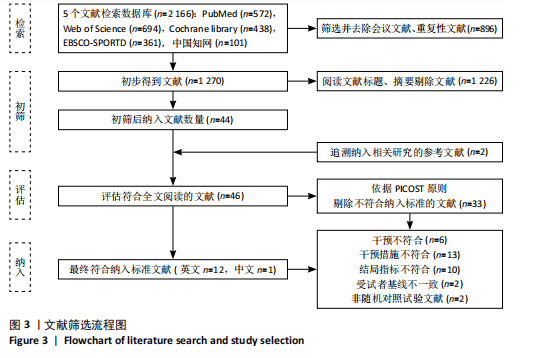
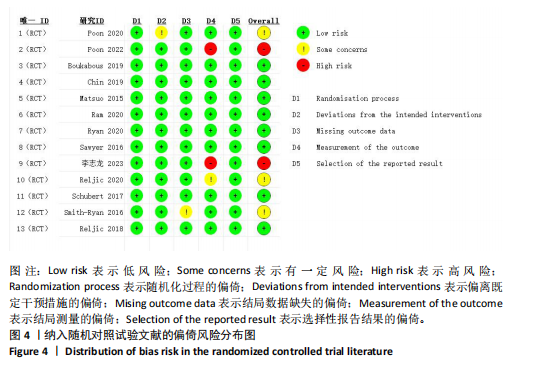
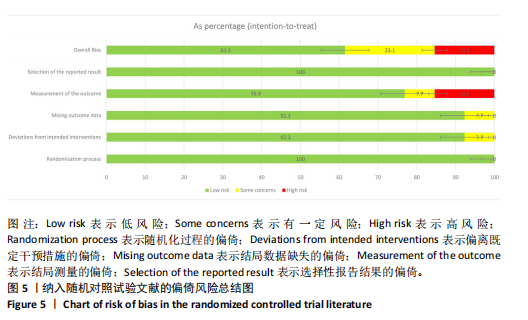
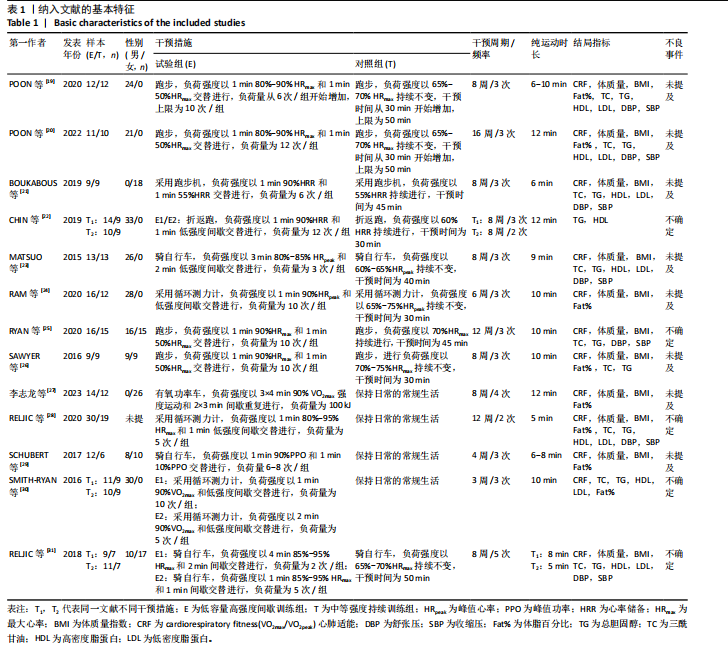
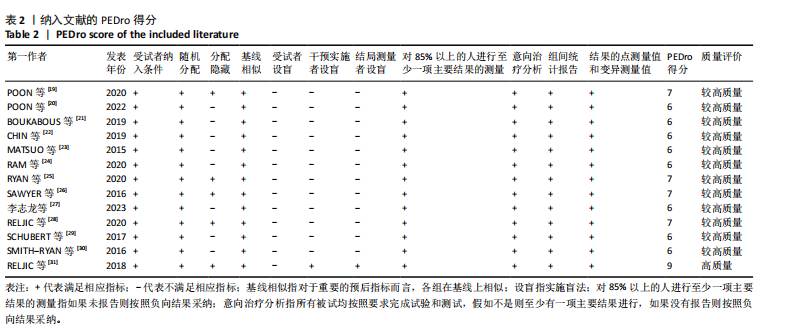
15.4%为“高风险”。文献整体偏倚分析发现,61.5%被评为“低风险”,23.1%为“有一定风险”以及15.4%为“高风险”。
2.4 Meta分析结果
2.4.1 低容量高强度间歇训练对肥胖或超重人群心血管功能干预效果的Meta分析心肺适能:低容量高强度间歇训练干预共纳入11项研究的13个效应量指标,共计患者174例[19-21,23-25,27-31]。研究间存在低度异质性(I2=26.38%),故选取固定效应模型。低容量高强度间歇训练合并效应量(SMD=-0.65,95%CI:-0.87至-0.43,P < 0.05)具有显著性意义,表明低容量高强度间歇训练干预可以改善心肺适能效果,见图6。低容量高强度间歇训练与中等强度持续训练相比共纳入7项研究的8个效应量指标,共计患者175例[19-20,23-24,29-31]。研究间不存在异质性(I2=0.00%),故选取固定效应模型。低容量高强度间歇训练与中等强度持续训练合并效应量(SMD=0.18,95%CI:-0.11-0.48,P > 0.05)不具有显著性意义,表明两者干预效果无显著性差异,见图7。
收缩压:低容量高强度间歇训练干预对共纳入7项研究的8个效应量指标,共计患者111例[19-21,23,25,28,31]。研究间不存在异质性(I2=0.00%),故选取固定效应模型。低容量高强度间歇训练合并效应量(SMD=0.38,95%CI:0.11-0.65,P < 0.05)具有显著性意义,表明低容量高强度间歇训练干预可以改善收缩压效果,见图8。低容量高强度间歇训练与中等强度持续训练相比共纳入6篇研究的7个效应量指标[19-21,23,25,31],共计患者147例。研究间存在低度异质性(I2=3.27%),故选取固定效应模型。低容量高强度间歇训练与中等强度持续训练合并效应量(SMD=0.14,95%CI:-0.18-0.46,P > 0.05)不具有显著性意义,表明两者比较干预效果无显著性差异,见图9。
舒张压:低容量高强度间歇训练干预对共纳入7项研究的8个效应量指标,共计患者111例[19-21,23,25,28,31]。研究间存在低度异质性(I2=32.29%),故选取固定效应
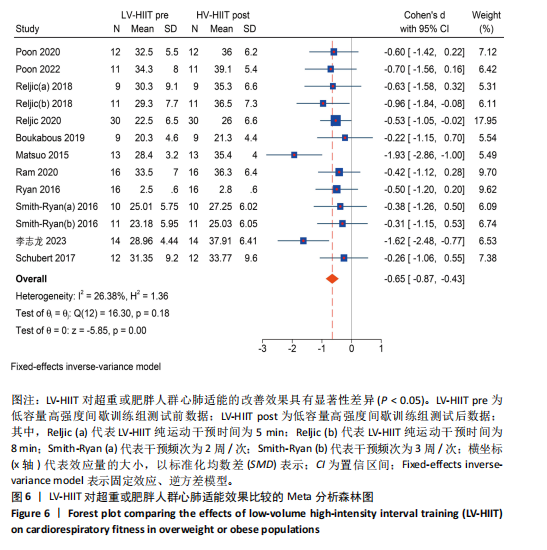
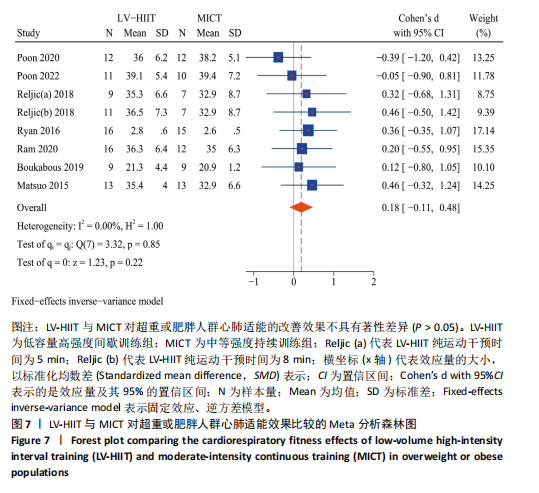
模型。低容量高强度间歇训练合并效应量(SMD=0.42,95%CI:0.15-0.68,P < 0.05)具有显著性意义,表明低容量高强度间歇训练干预可以改善舒张压效果,见图10。低容量高强度间歇训练与中等强度持续训练相比共纳入6项研究的7个效应量指标,共计患者147例[19-21,23,25,31]。研究间不存在异质性(I2=0.00%),故选取固定效应模型。低容量高强度间歇训练与中等强度持续训练合并效应量(SMD=-0.15,95%CI:-0.46-0.17,P > 0.05)不具有显著性意义,表明两者比较干预效果无显著性差异,见图11。
综合来看,低容量高强度间歇训练可以有效提升肥胖或超重人群心肺适能水平和促使肥胖或超重人群收缩压和舒张压水平降低,并恢复到血压正常值范围。低容量高强度间歇训练与中等强度持续训练相比发现,两组干预对心血管功能指标的改善效果相似,侧面说明短时间的低容量高强度间歇训练相比于长时间的中等强度持续训练更具有时间效益。
2.4.2 低容量高强度间歇训练对肥胖或超重人群体脂干预效果的Meta分析结果 见表3。
标准体质量:低容量高强度间歇训练干预研究纳入11项研究的12个效应量,共计患者136例[19-21,23-29,31]。研究间不存在异质性(I2=0.00%),故选取固定效应模型。低容量高强度间歇训练干预效果(SMD=0.14,95%CI:-0.08-0.35,P > 0.05)不具有显著性意义,表明合并效应量不具有显著性效果。低容量高强度间歇训练与中等强度持续训练相比研究纳入9项研究的10个效应量,共计患者193例[19-26,31]。研究间不存在异质性(I2=0.00%),故选取固定效应模型。低容量高强度间歇训练与中等强度持续训练干预效果(SMD=0.18,95%CI:-0.11-0.48,P > 0.05)不具有显著性意义,表明合并效应量不具有显著性效果。
体质量指数:低容量高强度间歇训练干预研究纳入11项研究的12个效应量,共计患者136例[19-21,23-29,31]。研究间不存在异质性(I2=0.00%),故选取固定效应模型。低容量高强度间歇训练干预效果(SMD=0.15,
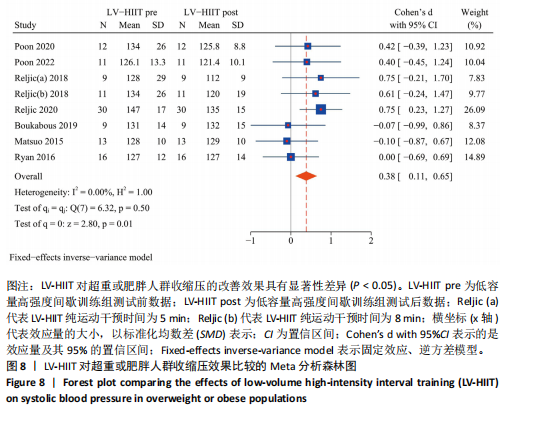
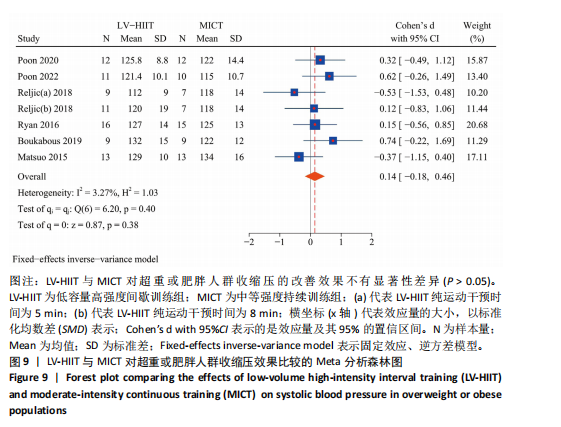

95%CI:-0.08-0.38,P > 0.05)不具有显著性意义,表明合并效应量不具有显著性效果。低容量高强度间歇训练与中等强度持续训练相比研究纳入8项研究的10个效应量,共计患者193例[19-21,23-26,31]。研究间不存在异质性(I2=0.00%),故选取固定效应模型。低容量高强度间歇训练与中等强度持续训练干预效果(SMD=-0.03,95%CI:-0.33-0.27,P > 0.05)不具有显著性意义,表明合并效应量不具有显著性效果。
体脂百分比:低容量高强度间歇训练干预研究纳入8项研究的9个效应量,共计患者109例[19-20,24,26-30]。研究间不存在异质性(I2=0.00%),故选取固定效应模型。低容量高强度间歇训练干预效果(SMD=0.25,95%CI:0.02-0.49,P < 0.05)具有显著性意义,表明合并效应量具有显著性效果。低容量高强度间歇训练与中等强度持续训练相比研究纳入5项研究的4个效应量,共计患者91例[19,20,24-26]。研究间不存在异质性(I2=0.00%),故选取固定效应模型。低容量高强度间歇训练与中等强度持续训练干预效果(SMD=0.09,95%CI:-0.26-0.45,P > 0.05)不具有显著性意义,表明合并效应量不具有显著性效果。
综合来看,低容量高强度间歇训练可以显著降低超重或肥胖人群体脂百分比(P < 0.05),但对标准体质量和身体质量分数改善无效果(P > 0.05)。低容量高强度间歇训练与中等强度持续训练相比对体脂干预效果3个指标方面均无显著优势(P > 0.05),说明低容量高强度间歇训练与中等强度持续训练干预效果相同,因此研究推断可能存在潜在的优势,但由于纳入相关研究较少,未来仍需相关研究验证在该方面的有效性。目前低容量高强度间歇训练在改善体脂方面效果虽然具有潜在优势,但仅在改善体脂百分比方面具有显著性效果,且支撑相关结果的试验数据偏少,故不进行低容量高强度间歇训练与中等强度持续训练两者间亚组分析、敏感性分析以及发表偏倚检验。
2.4.3 低容量高强度间歇训练对肥胖或超重人群血脂干预效果的Meta分析结果 见表4。
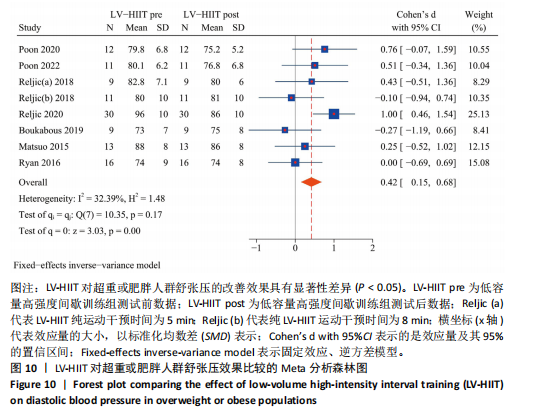
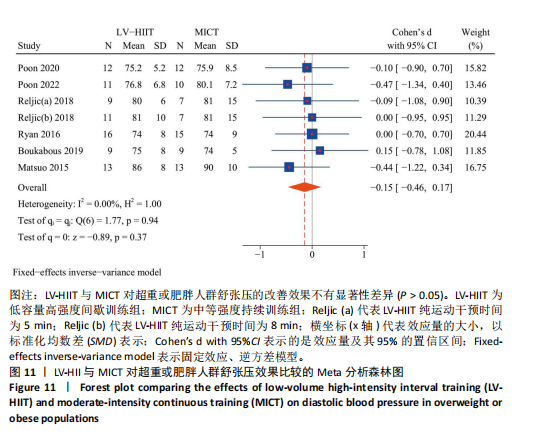
三酰甘油:低容量高强度间歇训练干预研究纳入10项研究的13个效应量,共计患者165例[19-23,25-26,28,30-31]。
研究间存在异质性(I2=0.00%),故选取固定效应模型。低容量高强度间歇训练干预效果(SMD=0.08,95%CI:-0.14-0.30,P > 0.05)不具有显著性意义,表明合并效应量不具有显著性效果。低容量高强度间歇训练与中等强度持续训练相比共纳入8项研究的10个效应量,共计患者198例[19-23,25-26,31]。研究间不存在异质性(I2=0.00%),故选取固定效应模型。低容量高强度间歇训练与中等强度持续训练干预效果(SMD=-0.30,95%CI:-0.57至-0.02,P < 0.05)具有显著性意义,表明合并效应量具有显著性效果。
总胆固醇:低容量高强度间歇训练干预研究纳入9项研究的11个效应量,共计患者141例[19-21,23,25-26,28,30-31]。研究间不存在异质性(I2=0.00%),故选取固定效应模型。低容量高强度间歇训练干预效果(SMD=0.11,95%CI:-0.13-0.36,P > 0.05)不具有显著性意义,表明合并效应量不具有显著性效果。低容量高强度间歇训练与中等强度持续训练相比共纳入7项研究的8个效应量,共计患者165例[19-21,23,25-26,31]。研究间存在低度异质性(I2=45.0%),故选取固定效应模型。低容量高强度间歇训练与中等强度持续训练干预效果(SMD=0.03,95%CI:-0.41-0.47,P > 0.05)不具有显著性意义,表明合并效应量不具有显著性效果。
高密度脂蛋白:低容量高强度间歇训练干预研究纳入8项研究的11个效应量,共计患者140例[19-23,28,30-31]。研究间不存在异质性(I2=0.00%),故选取固定效应模型。低容量高强度间歇训练干预效果(SMD=-0.16,95%CI:-0.39-0.08,P > 0.05)不具有显著性差异。低容量高强度间歇训练与中等强度持续训练相比共纳入6项研究的8个效应量,共计患者149例[19-23,31]。研究间不存在异质性(I2=0.00%),故选取固定效应模型。低容量高强度间歇训练与中等强度持续训练干预效果(SMD=0.29,95%CI:-0.03-0.60,P > 0.05)不具有显著性意义,表明合并效应量不具有显著性效果。
低密度脂蛋白:低容量高强度间歇训练干预研究纳入7项研究的9个效应量,共计患者116例[19-21,23,28,30-31]。研究间不存在异质性(I2=0.00%),故选取固定效应模型。低容量高强度间歇训练干预效果(SMD=0.22,95%CI:-0.04-0.48,P > 0.05)不具有显著性差异。低容量高强度间歇训练与中等强度持续训练相比共纳入5项研究的6个效应量,共计患者116例[19-21,23,31]。研究间存在中度异质性(I2=60.0%),故选取随机效应模型。低容量高强度间歇训练与中等强度持续训练干预效果(SMD=-0.08,95%CI:-0.67-0.50,P > 0.05)不具有显著性意义,表明合并效应量不具有显著性效果。
综上所述,低容量高强度间歇训练对超重或肥胖人群的三酰甘油、总胆固醇、高密度脂蛋白和低密度脂蛋白指标没有改善效果(P > 0.05)。但两者对比发现,中等强度持续训练对三酰甘油干预效果优于低容量高强度间歇训练(P < 0.05),但在改善总胆固醇、高密度脂蛋白和低密度脂蛋白方面两者效果相当,因此研究推断可能存在具有中等强度持续训练类似的效果,但由于纳入相关研究较少,未来仍需相关研究验证在该方面的有效性。目前低容量高强度间歇训练在改善血脂方面的效果仍待考究,但支撑相关结果的试验数据偏少,故不进行低容量高强度间歇训练与中等强度持续训练两者间亚组分析、敏感性分析以及发表偏倚检验。
2.4.4 亚组分析结果 设置调节变量对心脏适能、舒张压、收缩压指标进行低容量高强度间歇训练与中等强度持续训练亚组分析,经研究发现两组间异质性均小于50%,故合并效应量选取固定效应模型,见表5。干预类型方面,双臂试验和多臂试验对3个指标干预效果均无显著优势。样本量大小方面,小样本和大样本对3个指标干预效果均无显著优势。干预周期方面,干预小于8周、8周以及大于8周干预对3个指标干预效果均无显著优势。干预频次方面,干预2次/周和3次/周对3个指标均干预效果无显著优势。干预时间方面,干预t≤10 min和10 min < t≤15 min两者干预效果相似,且低容量高强度间歇训练更具有时间效益。
2.5 敏感性分析结果 为保证Meta分析结果的可靠性,文章进行了Leave-One-Out敏感性分析,即逐一移除每项研究并重新估算总体合并效应量的效果,以此考察任一单项研究对总体结果的影响,结果如图12-14所示。结果显示,有3项指标整体效应量在逐一剔除仍表现为一致性。这说明该Meta分析的结论对于个别研究影响不敏感,结果较为稳定,
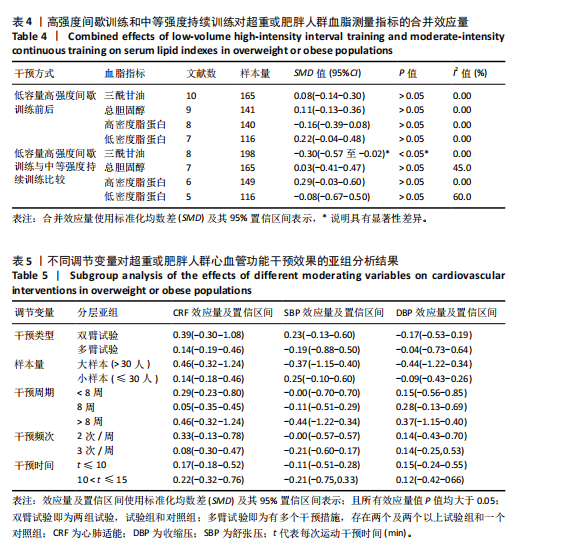
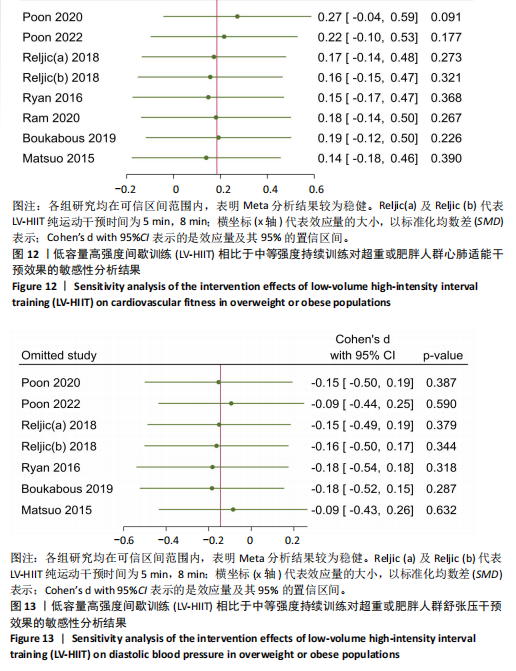
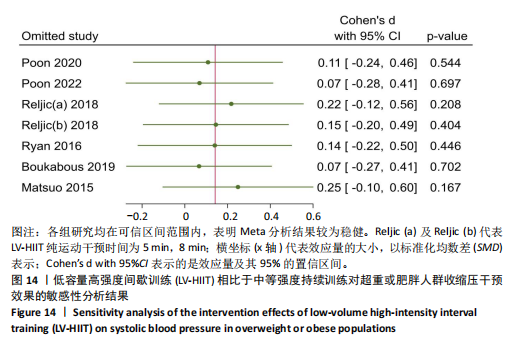
研究质量较高。
2.6 发表偏倚检验结果 发表偏倚是对系统评价中结果是否存在偏倚的一种检验,但由于研究纳入文献过少,该研究联合使用漏斗图结合Egger检验评估纳入研究整体的发表偏倚规模,即低容量高强度间歇训练相比于中等强度持续训练对心肺适能、收缩压和舒张压3个指标进行定性和定量分析[32]。Egger法检验结果,见表6,3个指标的P > 0.05,所有指标的发表偏倚漏斗图具有统计学上的显著对称性。因此,综合判断纳入的所有文献均不存在发表偏倚,见图15。
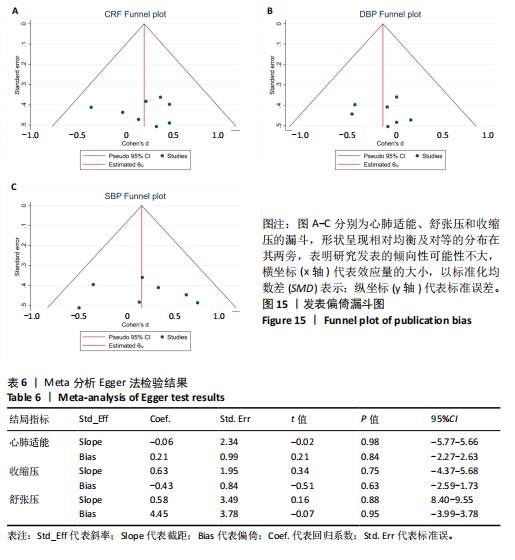
| [1] 李靖,张漓.健康中国建设中慢性病防治体医融合的试点经验、现实挑战及应对策略[J].体育科学,2020,40(12):73-82. [2] BREEN C, O CONNELL J, GEOGHEGAN J, et al. Obesity in adults: a 2022 adapted clinical practice guideline for Ireland. Obes Facts. 2022;15(6):736-752. [3] ELAGIZI A, KACHUR S, LAVIE CJ, et al. An overview and update on obesity and the obesity paradox in cardiovascular diseases. Prog Cardiovasc Dis. 2018;61(2):142-150. [4] PICHE M, TCHERNOF A, DESPRE J. Obesity phenotypes, diabetes, and cardiovascular diseases. Circ Res. 2020;126(11):1477-1500. [5] HORWIC TB, FONAROW GC, CLARK AL. Obesity and the obesity paradox in heart failure. Prog Cardiovasc Dis. 2018;61(2): 151-156. [6] NCD Risk Factor Collaboration (NCD-RiskC). Worldwide trends in underweight and obesity from 1990 to 2022: a pooled analysis of 3663 population-representative studies with 222 million children, adolescents, and adults. Lancet. 2024;403(10431):1027-1050. [7] DENG F, LV JH, WANG HL, et al. Expanding public health in China: an empirical analysis of healthcare inputs and outputs. Public health. 2017;142:73-84. [8] KEATING SE, MACHAN EA, O’Connor HT, et al. Continuous exercise but not high intensity interval training improves fat distribution in overweight adults. J Obes. 2014;2014:834865. [9] GHARDASHI-AFOUSI A, HOLISAZ MT, SHIRVANI H, et al. The effects of low-volume high-intensity interval versus moderate intensity continuous training on heart rate variability, and hemodynamic and echocardiography indices in men after coronary artery bypass grafting: a randomized clinical trial study. ARYA Atheroscler. 2018;14(6):260. [10] WANG Y, FAN C, CHENG L, et al. A comparative analysis of energy expenditure and substrate metabolism in male university students with overweight/obesity: Tabata vs HIIT and MICT. Front Endocrinol (Lausanne). 2024; 15:1323093. [11] WANG Y, WANG S, MENG X, et al. Effect of high-intensity interval training and moderate-intensity continuous training on cardiovascular risk factors in adolescents: Systematic review and meta-analysis of randomized controlled trials. Physiol Behav. 2024;275:114459. [12] WELSH A, HAMMAD M, PINA IL, et al. Obesity and cardiovascular health. Eur J Prevent Cardiol. 2024. doi: 10.1016/j.beem. 2013.01.004. [13] GIBALA MJ, LITTLE JP, MACDONALD MJ, et al. Physiological adaptations to low‐volume, high‐intensity interval training in health and disease. J Physiol. 2012;590(5): 1077-1084. [14] SABAG A, LITTLE JP, JOHNSON NA. Low‐volume high‐intensity interval training for cardiometabolic health. J Physiol. 2022; 600(5):1013-1026. [15] 高思垚,吕万刚,聂应军.不同运动方式对中国超重或肥胖人群代谢指标影响的元分析[J].中国体育科技,2021,57(10): 46-54. [16] VIANA RB, NAVES JPA, COSWIG VS, et al. Is interval training the magic bullet for fat loss? A systematic review and meta-analysis comparing moderate-intensity continuous training with high-intensity interval training (HIIT). Br J Sports Med. 2019;53(10):655-664. [17] MARTIN-SMITH R, COX A, BUCHAN DS, et al. High intensity interval training (HIIT) improves cardiorespiratory fitness (CRF) in healthy, overweight and obese adolescents: a systematic review and meta-analysis of controlled studies. Int J Environ Res Public Health.2020;17(8):2955. [18] YIN M, LI H, BAI M, et al. Is low-volume high-intensity interval training a time-efficient strategy to improve cardiometabolic health and body composition? A meta-analysis. Appl Physiol Nutr Metab. 2024;49(3):273-292. [19] POON ET, LITTLE JP, SIT CH, et al. The effect of low-volume high-intensity interval training on cardiometabolic health and psychological responses in overweight/obese middle-aged men. J Sports Sci. 2020;38(17):1997-2004. [20] POON ET, SIU PM, WONG PIPIT W, et al. Alternating high-intensity interval training and continuous training is efficacious in improving cardiometabolic health in obese middle-aged men. J Exerc Sci Fit. 2022;20(1):40-47. [21] BOUKABOUS I, MARCOTTE-CHENARD A, AMAMOU T, et al. Low-volume high-intensity interval training versus moderate-intensity continuous training on body composition, cardiometabolic profile, and physical capacity in older women. J Aging Phys Act. 2019;27(6):879-889. [22] CHIN EC, YU AP, LAI CW, et al. Low-frequency HIIT improves body composition and aerobic capacity in overweight men. Med Sci Sports Exerc. 2020;52(1):56-66. [23] MATSUO T, SO R, SHIMOJO N, et al. Effect of aerobic exercise training followed by a low-calorie diet on metabolic syndrome risk factors in men. Nutr Metab Cardiovasc Dis. 2015;25(9):832-838. [24] RAM A, MARCOS L, JONES MD, et al. The effect of high-intensity interval training and moderate-intensity continuous training on aerobic fitness and body composition in males with overweight or obesity: a randomized trial. Obes Med. 2020;17:100187. [25] RYAN BJ, SCHLEH MW, Ahn C, et al. Moderate-intensity exercise and high-intensity interval training affect insulin sensitivity similarly in obese adults. J Clin Endocrinol Metab. 2020; 105(8):e2941-e2959. [26] SAWYER BJ, TUCKER WJ, BHAMMAR DM, et al. Effects of high-intensity interval training and moderate-intensity continuous training on endothelial function and cardiometabolic risk markers in obese adults. J Appl Physiol. 2016;121(1):279-288. [27] 李志龙,单示标,解萧,等.高、低运动量HIIT对青年肥胖女性减肥效果的对比研究[J].南京体育学院学报,2023,22(5): 40-46. [28] RELJIC D, FRENK F, HERRMANN HJ, et al. Low-volume high-intensity interval training improves cardiometabolic health, work ability and well-being in severely obese individuals: a randomized-controlled trial sub-study. J Transl Med. 2020;18:1-15. [29] SCHUBERT MM, CLARKE HE, SEAY RF, et al. Impact of 4 weeks of interval training on resting metabolic rate, fitness, and health-related outcomes. Appl Physiol Nutr Metab. 2017;42(10):1073-1081. [30] SMITH-RYAN AE, TREXLER ET, WINGFIELD HL, et al. Effects of high-intensity interval training on cardiometabolic risk factors in overweight/obese women. J Sports Sci. 2016;34(21):2038-2046. [31] RELJIC D, WITTMANN F, FISCHER JE. Effects of low-volume high-intensity interval training in a community setting: a pilot study. Eur J Appl Physiol. 2018;118:1153-1167. [32] EGGER M, SMITH GD, SCHNEIDER M, et al. Bias in meta-analysis detected by a simple, graphical test. BMJ. 1997;315(7109):629-634. [33] FISHMAN B, SHLOMAI G, TWID G, et al. Renal glucosuria is associated with lower body weight and lower rates of elevated systolic blood pressure: results of a nationwide cross-sectional study of 2.5 million adolescents. Cardiovasc Diabetol. 2019;18:1-8. [34] JUNG ME, LOCKE SR, BOURNE JE, et al. Cardiorespiratory fitness and accelerometer-deter mined physical activity following one year of free-living high-intensity interval training and moderate-intensity continuous training: a randomized trial. Int J Behav Nutr Phys Act. 2020;17:1-10. [35] LIU Y, ZHI-JIAN W, BAO-HU L, et al. Relationships between cardiopulmonary function and dangerous cardiovascular factors in Chinese adults: a cross-sectional study. 2024. doi:10.21203/rs.3.rs-3938895/v1. [36] CHEN X, HE H, XIE K, et al. Effects of various exercise types on visceral adipose tissue in individuals with overweight and obesity: a systematic review and network meta‐analysis of 84 randomized controlled trials. Obes Rev. 2024;25(3):e13666. [37] SWIFT DL, JOHANNSEN NM, LAVIE CJ, et al. The role of exercise and physical activity in weight loss and maintenance. Prog Cardiovasc Dis. 2014;56(4):441-447. [38] THOMPSON PD, ARENA R, RIEBE D, et al. ACSM’s new preparticipation health screening recommendations from ACSM’s guidelines for exercise testing and prescription. Curr Sports Med Rep. 2013; 12(4):215-217. [39] 殷明越,陈志力,李汉森,等.碎片化运动:兼具应用可行性与健康促进效果的新策略[J].西安体育学院学报,2023,40(5):615-627. [40] LITTLE JP, LANGLEY J, LEE M, et al. Sprint exercise snacks: a novel approach to increase aerobic fitness. Eur J Appl Physiol. 2019;119:1203-1212. [41] REED JL, TERADA T, COTIE LM, et al. The effects of high-intensity interval training, Nordic walking and moderate-to-vigorous intensity continuous training on functional capacity, depression and quality of life in patients with coronary artery disease enrolled in cardiac rehabilitation: a randomized controlled trial. Prog Cardiovasc Dis. 2022;70:73-83. [42] PETERMAN JE, HARBER MP, IMBODEN MT, et al. Accuracy of exercise-based equations for estimating cardiorespiratory fitness. Med Sci Sports Exerc. 2021;53(1):74. [43] GONCALVES C, RAIMUNDO A, Abreu A, et al. Exercise intensity in patients with cardiovascular diseases: systematic review with meta-analysis. Int J Environ Res Public Health. 2021;18(7):3574. [44] ANDO T, PIAGGI P, BOGARDUS C, et al. VO2max is associated with measures of energy expenditure in sedentary condition but does not predict weight change. Metabolism. 2019; 90:44-51. [45] HARBER MP, MYERS J, BONIKonikowske AR, et al. Assessing cardiorespiratory fitness in clinical and community settings: Lessons and advancements in the 100th year anniversary of VO2max. Prog Cardiovasc Dis. 2024;83:36-42. [46] TJØNNA AE, LEINAN IM, BARTNES AT, et al. Low-and high-volume of intensive endurance training significantly improves maximal oxygen uptake after 10-weeks of training in healthy men. PLoS One. 2013; 8(5):e65382. [47] VOLLAARD NB, METCALFE RS. Research into the health benefits of sprint interval training should focus on protocols with fewer and shorter sprints. Sports Med. 2017;47:2443-2451. [48] DU L, ZHANG X, CHEN K, et al. Effect of high-intensity interval training on physical health in coronary artery disease patients: a meta-analysis of randomized controlled trials. J Cardiovasc Dev Dis. 2021; 8(11):158. [49] YUE T, WANG Y, LIU H, et al. Effects of high-intensity interval vs. moderate-intensity continuous training on cardiac rehabilitation in patients with cardiovascular disease: a systematic review and meta-analysis. Front Cardiovasc Med. 2022;9:845225. [50] RELJIC D, KOLLER A, HERRMANN HJ, et al. Differential effects of very-low-volume exercise modalities on telomere length, inflammation, and cardiometabolic health in obese metabolic syndrome patients: a subanalysis from two randomized controlled trials. Antioxidants.2023;12(10):1847. [51] BIRKETT ST, NICHOLS S, SAWREY R, et al. The effects of low-volume high-intensity interval training and circuit training on maximal oxygen uptake. J Sports Med Phys Fitness. 2019;15:443-451. [52] GHARDASHI-AFOUSI A, HOLISAZ MT, Shirvani H, et al. The effects of low-volume high-intensity interval versus moderate intensity continuous training on heart rate variability, and hemodynamic and echocardiography indices in men after coronary artery bypass grafting: a randomized clinical trial study. ARYA atheroscler. 2018;14(6):260. [53] LYALL DM, CELIS-MORALES C, WARD J, et al. Association of body mass index with cardiometabolic disease in the UK Biobank: a Mendelian randomization study. JAMA Cardiol. 2017;2(8):882-889. [54] FEIGIN VL, STARK BA, JOHNSON CO, et al. Global, regional, and national burden of stroke and its risk factors, 1990–2019: a systematic analysis for the Global Burden of Disease Study 2019. Lancet Neurol. 2021;20(10):795-820.
[55] MARCEAU F, REGOLI D. Bradykinin receptor ligands: therapeutic perspectives. Nat Rev Drug Discov. 2004;3(10):845-852. [56] SHARMA JN. Hypertension and the bradykinin system. Curr Hypertens Rep. 2009;11(3):178-181. [57] PAL S, RADAVELLI-BAGATINI S, HO S. Potential benefits of exercise on blood pressure and vascular function. J Am Soc Hypertens. 2013;7(6):494-506. [58] WHELTONS P, CHIN A, XIN X, et al. Effect of aerobic exercise on blood pressure: a meta-analysis of randomized, controlled trials. Ann Intern Med. 2002;136(7):493-503. [59] GRASSI G, MARK A, ESLER M. The sympathetic nervous system alterations in human hypertension. Circ Res. 2015; 116(6):976-990. [60] WAY KL, SABAG A, SULTANA RN, et al. The effect of low-volume high-intensity interval training on cardiovascular health outcomes in type 2 diabetes: a randomised controlled trial. Int J Cardiol. 2020;320:148-154. [61] OLEA MA, MANCILLA R, MARTINEZ S, et al. Effects of high intensity interval training on blood pressure in hypertensive subjects. Rev Med Chil. 2017;145(9):1154-1159. [62] LEE K, SONG YM, SUNG J. Which obesity indicators are better predictors of metabolic risk?: healthy twin study. Obesity. 2008;16(4):834-840. [63] WINDING KM, MUNCH GW, LEPSEN UW, et al. The effect on glycaemic control of low‐volume high‐intensity interval training versus endurance training in individuals with type 2 diabetes. Diabetes Obes Metab. 2018;20(5):1131-1139. [64] SULTANA RN, SABAG A, KEATING SE, et al. The effect of low-volume high-intensity interval training on body composition and cardiorespiratory fitness: a systematic review and meta-analysis. Sports Med. 2019;49:1687-1721. [65] Li F, NIE J, ZHANG H, et al. Effects of matched intermittent and continuous exercise on changes of cardiac biomarkers in endurance runners. Front Physiol. 2020; 11:30. [66] ALVES JW, FARIAS-JUNIOR LF, Alves CPDL, et al. Low-volume high-intensity interval training sessions with different work-recovery durations and muscle damage in trained men. Res Q Exerc Sport. 2023;94(1):73-81. [67] PURDOM T, KRAVITZ L, DOKLADNY K, et al. Understanding the factors that effect maximal fat oxidation. J Int Soc Sports Nutr. 2018;15(1):3. [68] MEDICA EM. Excess post-exercise oxygen consumption and fat oxidation in recreationally trained men following exercise of equal energy expenditure: comparisons of spinning and constant endurance exercise. J Sports Med Phys Fitness. 2017;(12):1781-1789. [69] WANNAMETHEE G, SHAPER AG. The association between heart rate and blood pressure, blood lipids and other cardiovascular risk factors. J Cardiovasc Risk. 1994;1(3):223-230. [70] KARIM MN, AHMED KR, Bukht MS, et al. Pattern and predictors of dyslipidemia in patients with type 2 diabetes mellitus. Diabetes Metab Syndr. 2013;7(2):95-100. [71] TOBERT JA, NEWMAN CB. Management of dyslipidemia for cardiovascular disease risk reduction. Ann Intern Med. 2016; 164(7):509. [72] HEDAYATINA M, ASADI Z, ZARE-FEYZABADI R, et al. Dyslipidemia and cardiovascular disease risk among the MASHAD study population. Lipids Health Dis. 2020;19:1-11. [73] WARNER SO, YAO MV, CASON RL, et al. Exercise-induced improvements to whole body glucose metabolism in type 2 diabetes: the essential role of the liver. Front Endocrinol. 2020;11:557166. [74] TREFTS E, WILLIAMS AS, WASSERMAN DH. Exercise and the regulation of hepatic metabolism. Prog Mol Biol Transl Sci. 2015; 135:203-225. [75] PETERSEN AMW, Pedersen BK. The anti-inflammatory effect of exercise. J Appl Physiol. 2005;98(4):1154-1162. [76] ISLAM H, GIBALA MJ, Little JP. Exercise snacks: a novel strategy to improve cardiometabolic health. Exerc Sport Sci Rev. 2022;50(1):31-37. [77] YIN M, DENG S, CHEN Z, et al. Exercise snacks are a time-efficient alternative to moderate-intensity continuous training for improving cardiorespiratory fitness but not maximal fat oxidation in inactive adults: a randomized controlled trial. Appl Physiol Nutr Metab. 2024. doi: 10.1139/apnm-2023-0593. [78] NIESTE I, FRANSSEN WM, SPAAS J, et al. Lifestyle interventions to reduce sedentary behaviour in clinical populations: a systematic review and meta-analysis of different strategies and effects on cardiometabolic health. Prev Med. 2021; 148:106593. [79] GARDNER B, SMITH L, LORENCATTO F, et al. How to reduce sitting time? A review of behaviour change strategies used in sedentary behaviour reduction interventions among adults. Health Psychol Rev. 2016;10(1):89-112. |
| [1] | 陈佳永, 唐梅玲, 卢健棋, 庞 延, 杨尚冰, 毛美玲, 罗文宽, 陆 微. 基于孟德尔随机化分析欧洲人群代谢物与肌少症的因果关系及其代谢物与 心血管疾病的相关性分析[J]. 中国组织工程研究, 2025, 29(在线): 1-11. |
| [2] | 孙韫頔, 程露露, 万海丽, 常 赢, 熊雯娟, 夏 渊. 神经肌肉训练对膝骨关节炎患者疼痛和功能影响的Meta分析[J]. 中国组织工程研究, 2025, 29(9): 1945-1952. |
| [3] | 王艺达, 刘 君, 王晓玲, 王丽岩, 杨程茹, 张学晓. 基于可穿戴电子设备干预对健康青少年身体活动和久坐行为影响的Meta分析[J]. 中国组织工程研究, 2025, 29(8): 1693-1704. |
| [4] | 张孜贤, 徐有粮, 吴绍奎, 王相英. 血流限制训练法联合抗阻训练对运动者肌肉相关指标影响的Meta分析[J]. 中国组织工程研究, 2025, 29(8): 1705-1713. |
| [5] | 王 娟, 王广兰, 左会武. 运动疗法对前交叉韧带重建后康复疗效影响的网状Meta分析[J]. 中国组织工程研究, 2025, 29(8): 1714-1726. |
| [6] | 郑华坤, 殷明越, 刘 骞. 间歇与持续训练对体力活动不足成人生活质量影响的Meta分析[J]. 中国组织工程研究, 2025, 29(8): 1727-1740. |
| [7] | 王 锋, 曹春风, 何 超, 张 涛, 周子弦, 朱凤臣. 关节镜下全内技术与传统技术重建前交叉韧带:疗效和放射学结果的Meta分析[J]. 中国组织工程研究, 2025, 29(35): 7629-7638. |
| [8] | 田金鑫, 赵玉欣, 胡 通, 崔甜甜, 马丽虹. 经颅磁刺激不同模式干预成人难治性抑郁症的网状Meta分析[J]. 中国组织工程研究, 2025, 29(35): 7639-7648. |
| [9] | 刘晨晨, 刘锐泽, 鲍蒙蒙, 方 李, 曹立全, 毋江波. 血流限制训练干预老年肌少性肥胖[J]. 中国组织工程研究, 2025, 29(32): 6963-6970. |
| [10] | 吴振桦, 张锡玮, 王一品, 李倩倩. 血清血脂7项与骨关节炎的关系:IEU OPEN GWAS数据库欧洲人群的大样本分析[J]. 中国组织工程研究, 2025, 29(32): 7004-7014. |
| [11] | 王 贺, 于少泓, . 经颅直流电刺激改善脑卒中患者下肢运动功能障碍的Meta分析[J]. 中国组织工程研究, 2025, 29(30): 6556-6565. |
| [12] | 刘利国, 丘明旺, 黄艳玲, 范志勇, 吴 山, 郭汝松. 基于CONSORT声明和STRICTA清单评价针灸推拿治疗枕大神经痛的随机对照试验报告质量[J]. 中国组织工程研究, 2025, 29(30): 6566-6573. |
| [13] | 刘昊为, 田浩冬, 黄 丽, 余杭林, 彭 莉. 血流限制抗阻运动对肥胖青年男性血清代谢物的急性影响[J]. 中国组织工程研究, 2025, 29(29): 6249-6259. |
| [14] | 虞兵兵, 王婷婷, 方俊霖, 郭 云, 黄英如. 针灸治疗绝经后骨质疏松症的Meta分析、系统评价和试验序贯分析[J]. 中国组织工程研究, 2025, 29(29): 6305-6316. |
| [15] | 陈锦杰, 李 庚, 姜烨凡. Siblings蛋白家族在多种心脏疾病中的作用[J]. 中国组织工程研究, 2025, 29(24): 5171-5178. |
通过运动干预有效控制肥胖仍是目前最安全和经济的减肥方式,传统运动干预以中等强度的持续训练为主,其特点为通过中低强度不间断地进行持续时间超过30 min以上的运动[7]。虽然中等强度持续训练可以有效提高脂肪分解能力,改善体内糖脂代谢和心肺功能,从而达到减肥和促进代谢的效果[8],但由于其耗时长和运动形式枯燥单一等缺点导致大众群体参与的兴趣不足。近些年兴起的高强度间歇训练逐渐成为减脂的高效运动手段,其特点是强度大并且时间短,对心肺刺激和人体代谢优于中等强度持续训练[9-12]。高强度间歇训练以累积15 min高强度运动时间为界分为高容量高强度间歇训练和低容量高强度间歇训练两类[13]。低容量高强度间歇训练定义为负荷强度在80%-100%最大摄氧量或最大心率之间,在两次练习之间安排低强度的恢复性练习,全部高强度运动时间≤15 min,这其中不包含热身、间歇以及恢复时间[14]。虽然国内外相关研究已经证实高强度间歇训练与中等强度持续训练对肥胖或超重人群均具有减肥效果和促进身体代谢的作用[15-17],但关于低容量高强度间歇训练是否在改善肥胖人群身体健康方面优于中等强度持续训练尚存在争议,且国内外缺少此类相关对比的Meta分析。低容量高强度间歇训练作为衍生出的新兴干预方式对肥胖或超重人群患心血管相关疾病的风险因子干预具有潜在的优势[18]。
因此,文章通过Meta分析探讨低容量高强度间歇训练与中等强度持续训练对心血管相关疾病风险因子的干预效果,以期为肥胖或超重人群提供科学高效的运动干预方案和运动实践指导意见。
中国组织工程研究杂志出版内容重点:组织构建;骨细胞;软骨细胞;细胞培养;成纤维细胞;血管内皮细胞;骨质疏松;组织工程
该方案已在国际系统综述前瞻性注册中心注册(CRD42024534409)。
1.1 文献检索
1.1.1 检索者 第一、四作者采用独立双盲的方式进行文献检索,并严格遵循《系统综述与荟萃分析优先报告条目:PRISMA声明》。
1.1.2 资料库 中国知网、PubMed、Web of Science、Cochrane library及EBSCO-SPORTD运动科学全文数据库。
1.1.3 检索词 中文检索词为“肥胖,超重,体质量,高强度间歇训练,中等强度的持续训练,低容量高强度间歇训练”,英文检索词为“fat,obesity,overweight,VO2max,body mass index,BMI,high intensity interval training,HIIT,moderate intensity continuous training,MICT,low-volume high intensity interval training,LV-HIIT”。
1.1.4 检索时限 各数据库建库至2024年2月(最后一次检索在2024-02-29)。
1.1.5 文献检索策略 以PubMed和中国知网数据库为例,检索策略见图1。
1.2 纳入和排除标准 遵循PICOST原则进行文献纳入标准的制定,从纳入文献类型、干预对象、干预措施以及结局指标4个方面进行筛选与评估。
1.2.1 纳入标准 ①纳入文献类型:所纳入文献均为中英文的临床随机对照试验;②干预对象:成年肥胖/超重患病人群;③干预措施:受试者干预周期≥3周,试验组仅为低容量高强度间歇训练运动干预,对照组为中等强度持续训练或不进行任何运动处方干预,仅保持常规活动量,且试验组和对照组受试者的基线情况保证一致,见图2;④结局指标:心血管风险因子指标以心肺适能(最大摄氧量和峰值心率)和血压(收缩压和舒张压)为主;次要指标为可直接提供评价的体脂指标(体质量、体质量指数、体脂百分比)和血脂指标(高密度脂蛋白、低密度脂蛋白、三酰甘油和总胆固醇)。
1.2.2 排除标准 ①研究类型为文献综述或会议性文献;②重复发表或数据无法提取的文献;③研究非中英文文献;④非超重/肥胖以及伴有其他严重慢性疾病的成年人;⑤急性运动干预研究。
1.3 文献筛选 对检索到的文献通过NoteExpress 3.2.0软件进行去重,由第一、五作者通过阅读标题摘要进行初筛,阅读全文并根据纳入与排除标准进行最终筛选,确定纳入文献。当意见有所分歧时,由第六作者介入讨论。
1.4 资料提取 根据文章所需要的资料数据由第一作者进行一次提取,并由第二作者进行审校。主要内容包括:文章第一作者、发表年份、受试者基本信息、干预方法与措施、结局指标等相关数据。结局指标数据以Mean±SD的形式提取试验组和对照组的后测值以及试验组的前测值。结局指标相关数据无法从文中直接获取时,将第一时间向通讯作者索取。
1.5 文献方法学质量评估 对纳入文献进行方法学质量评估是评价文献研究规范的重要指标,研究采用Risk of Bias 2.0工具(RoB 2.0,Cochrane协作网,2021修订版)进行偏倚风险评估。随机对照试验评分标准包括:随机化过程偏倚、干预措施的偏倚、结局数据缺失的偏倚、结局测量的偏倚、选择性报告结果的偏倚和整体偏
倚。将纳入的文献从低到高分为3个等级:low risk即偏倚评估为低风险;unclear即偏倚风险不确定或信息匮乏;high risk即偏倚评估为高风险。由第一、二作者对纳入研究的13篇文献采取独立双盲的方式进行评价。
采取PEDro (Physiotherapy Evidence Database,物理治疗证据数据库)量表来评估文献的稳健性。PEDro量表10分为满分,符合相应标准得1分,不符合则为0分。共计11个题目(第1题不计入得分)。由第一、三作者根据得分标准进行独立评价,9-10分即为高质量文献、6-8分即为较高质量文献、4-5分属于一般质量文献、低于4分为低质量文献。
1.6 结局指标 主要指标包括心肺适能(cardiorespiratory fitness,CRF)、舒张压(diastolic blood pressure,DBP)和收缩压(systolic blood pressure,SBP)。次要结局指标包括体脂和血脂两项:体脂指标包括标准体质量、体质量指数(body mass index,BMI)和体脂百分比(body fat percentage,Fat%);血脂指标包括高密度脂蛋白(high-density lipoprotein,HDL)、低密度脂蛋白(low-density lipoprotein,LDL)、三酰甘油(triglyceride,TG)、总胆固醇(total cholesterol,TC)。
1.7 统计学分析 采用Cochrane协助网的软件RevMan 5.4和软件Stata 17.0进行Meta分析,包括合并效应量、森林图制作、检验异质性大小、亚组分析、发表敏感性分析以及发表偏倚Egger检验和漏斗图的绘制。对纳入符合标准文献根据异质性大小采取固定效应或随机效应模型进行Meta分析。鉴于试验数据为连续型变量且结局指标单位均一致,分析采取标准化均数差(STD Mean Difference,SMD)及其95%置信区间(95% Confidence Interval,95% CI)。采用P值进行合并统计量检验,当P ≤ 0.05时,合并效应具有显著性意义,若P > 0.05,合并效应没有显著性意义。采用I2统计量检验统计学异质性大小,I2 < 50%为低度异质性,50% < I2 < 75%为中度异质性,I2≥75%为高度异质性。当I2≥50%时,应为采取随机效应模型。采用Leave-One-Out方法进行敏感性分析,以检验整体效果估计的一致性。效应量的评判依据为:SMD < 0.2即为微小效应量,0.2≤SMD < 0.5即为小效应量,0.5≤SMD < 0.8即为中等效应量,SMD≥0.8即为大效应量。通过漏斗图和Egger检验对文献的发表偏倚进行评估,如果漏斗图呈现不对称性或Egger检验的P < 0.05,则认为存在发表偏倚,反之P > 0.05即为不存在。
研究发现,低容量高强度间歇训练的特点在于总体运动量较小,运动强度较大,且具有更高的时间效益,最普遍的运动方式为功率车、循环测力器以及跑步机进行干预。在运动过程中,机体发生神经动员促使运动系统和内脏系统进入工作状态,一定范围内动员程度与运动强度呈正相关,强度越高,其动员程度也就越大[41]。相关报告称,低容量高强度间歇训练在心血管疾病康复过程产生改善效果的基本机制主要取决于运动强度,可以使患者的心血管系统在高强度运动中得到更大程度的动员,进而促进心肺适能提高[43]。因此,通过对比两种干预方案对超重或肥胖人群心血管风险因子的干预效果,进一步验证和探索低容量高强度间歇训练的可行性和有效性。
3.1 低容量高强度间歇训练对改善肥胖或超重人群心肺适能效果的影响 心肺适能是评定心血管疾病和死亡率强有力的预测因子,VO2max和VO2peak是评价心肺适能的经典指标[44-45]。
因此,心肺适能的提高是对肥胖或超重人群预防心血管相关疾病的重点。Meta分析显示,低容量高强度间歇训练对肥胖或超重人群心肺适能合并效应量具有显著性效果,达到中等效应量,说明低容量高强度间歇训练可以有效提升肥胖或超重人群的心肺适能。低容量高强度间歇训练与中等强度持续训练对肥胖或超重人群心肺适能合并效应量不具有显著性差异,说明两种训练干预效果相差不大,这与大部分研究结果一致。
TJØNNA等[46]探索了低容量高强度间歇训练对超重或肥胖患者的影响以及在患者治疗中引入低容量高强度间歇训练的可行性,该研究将26例不活跃但健康的超重男性患者随机分为低容量高强度间歇训练组和高容量高强度间歇训练组并进行生活质量问卷的测评,结果表明低容量高强度间歇训练同样可以提高患者的心肺适能效果和降低了心血管风险因子,并称能更容易转战公共卫生领域。此外,还有大量研究论证了在心血管疾病患者的治疗过程中运用低容量高强度间歇训练的效果,高强度运动对心肺适能的改善效果基本达成共识。在康复中运用低容量高强度间歇训练的优势还体现在具有较高的效率,VOLLAARD等[47]讨论了低容量高强度间歇训练与其他运动方式在改善效率的差异,结果显示尽管低容量高强度间歇训练锻炼时间较短,但在提高心肺适能方面的效用不会因时间缩短而降低,效果甚至还会更佳。
同时,影响低容量高强度间歇训练康复效果的因素还有运动的持续时间,DU等[48]和YUE等[49]的研究显示当低容量高强度间歇训练介入治疗持续达到12周或更长时,可以为心血管疾病患者带来较为显著的康复成效。由此看出,对心血管疾患者和超重或肥胖人群来说,低容量高强度间歇训练在改善心肺适能方面具有显著效果。
3.2 低容量高强度间歇训练对改善肥胖或超重人群血压效果的影响 血压是评定心血管系统健康和反映心脏功能状态的重要指标,包括收缩压和舒张压[50-51]。因此,改善超重或肥胖人群的血压对心血管疾病的预防有重要意义[52]。Meta分析显示,低容量高强度间歇训练对肥胖或超重人群收缩压、舒张压合并效应量均具有显著性差异,说明低容量高强度间歇训练对肥胖或超重人群的血压具有调控作用。低容量高强度间歇训练与中等强度持续训练对肥胖或超重人群在收缩压和舒张压合并效应量不具有显著性差异,说明两种训练干预效果相差不大,这与大部分研究结果一致。
流行病学表明,肥胖或超重是高血压发病的重要危险因素,其中高血压引起的心脑血管疾病是人类致死和致残的首要因素[53-54]。众所周知,降血压作用途径包括阻止缓激肽被分解,并提升其浓度,继而促进一氧化氮和前列腺素的产生,从而导致血压下降[55-56]。通过运动干预同样可获得与药物疗效相似的结果。由运动训练引发的一氧化氮的产生增加及其生物可用性的提高,可能构成高血压病患者减压的主要作用机制[57-58]。此外,有研究意见指出高血压的形成与交感神经系统活动过度密切相关[59]。
WAY等[60]研究发现,低容量高强度间歇训练可能是一种有效的时间策略,通过与中等强度持续训练相比,发现低容量高强度间歇训练可显著改善肥胖2型糖尿病患者的中心动脉僵硬度和心血管疾病患病风险,为这种训练的潜在心血管益处提供了新的见解。OLEA等[61]对27例没有遵医嘱服用降压药的患者进行了为期8周的功率车运动训练,发现患者的收缩压平均降低27.7 mmHg,心肺耐力得到提高。
综上发现,低容量高强度间歇训练改善血压水平可能与多种机制有关,是多项结果的综合体现。
3.3 低容量高强度间歇训练对改善肥胖或超重人群体脂效果的影响 标准体质量、体质量指数以及体脂百分比是对肥胖或超重人群减重效果评价的重要指标[62]。Meta分析显示,低容量高强度间歇训练在改善标准体质量、体质量指数方面均不具有显著性效果,但对体脂百分比干预效果具有显著性差异,表明低容量高强度间歇训练对肥胖或超重人群减脂是具有效果的。低容量高强度间歇训练与中等强度持续训练对比中发现,两者在标准体质量、体质量指数以及体脂百分比3个指标方面干预效果相似,因此,足以证实低容量高强度间歇训练似乎具有更高的时间效益。但文章与前人研究存在一定区别,作者推断可能由于目前低容量高强度间歇训练仍处于研究空白阶段,相关文章较少导致结果偏差,从而导致标准体质量以及体质量指数方面效果不显著。
另外,影响低容量高强度间歇训练减肥效果的因素还有干预频次,WINDING等[63]和CHIN等[22]证实在选取低容量高强度间歇训练不同的频次和相同的周期进行运动干预后,发现每周进行3次负荷强度以95%HRmax的低容量高强度间歇训练,可以有效降低肥胖或超重人群的体质量,甚至CHIN等[22]发现减少至每周进行一次负荷强度以90%HRmax的运动干预,进行8周后依旧具有减重和减脂的效果。SULTANA等[64]的Meta分析发现,低容量高强度间歇训练在降低体脂指标方面并没有效果,虽然研究结果与文章不一致,但其样本特征与文章有很大不同,在纳入的47项研究中,仅有26项研究纳入了肥胖或超重人群,其肥胖或超重人群全身脂肪较多,通过运动减少体质量和体脂更容易表现出显著性意义。与此同时,低容量高强度间歇训练可以在训练时以能量消耗更少的情况下达到与中等强度持续训练相似的全身减脂效果[65-66],这可能是由于运动干预后过量耗氧量增加,脂肪氧化增加,从而达到抑制食欲的效果有 关[67-68]。
综合而言,低容量高强度间歇训练是一种降低体质量和体脂的有效方法,其效果与中等强度持续训练相当,且所需的能量和时间更少。
3.4 低容量高强度间歇训练对改善肥胖或超重人群血脂效果的影响 血清中血脂代谢标志物水平与心血管及代谢性疾病的发病率显著相关,血脂指标分别为高密度脂蛋白、高密度脂蛋白、总胆固醇和三酰甘油。因此,维持血脂代谢健康是对肥胖或超重人群提高生活质量和预防疾病发生的重要前提[69-70]。血脂异常是形成心血管疾病的主要因素之一,主要表现为高密度脂蛋白、总胆固醇和三酰甘油出现上升,而高密度脂蛋白出现下降的趋势,这类疾病大多症状并不明显,却时刻影响着人体健康[71-73]。Meta分析结果显示,低容量高强度间歇训练在改善高密度脂蛋白、高密度脂蛋白、总胆固醇和三酰甘油4个指标方面均未有显著性效果;但与中等强度持续训练对比中发现,在三酰甘油指标方面,中等强度持续训练效果优于低容量高强度间歇训练。POON等[19]招募24例肥胖患者进行为期8周的低容量高强度间歇训练后发现,低容量高强度间歇训练在改善肥胖患者的高密度脂蛋白、三酰甘油、总胆固醇和高密度脂蛋白4个指标方面同样未有显著性效果,这与文章具有一致性。关于运动调节血脂代谢的主要机制,有研究表明有氧运动主要通过影响与血脂代谢相关酶的活性和含量,以及与血脂代谢的相关受体而发挥作用,可以有效降低炎症因子的表达,减轻肝脏的炎症水平,提高胰岛素敏感度,并通过激活骨骼肌过氧化物酶体增殖物激活受α和γ mRNA的表达,促进葡萄糖和脂肪的氧化分解,改善肝脏脂代谢水平[74-75]。
综上,虽然文章并未发现低容量高强度间歇训练在改善血脂指标方面有显著优势,但其在改善血脂四项方面似乎具有潜在的效果。基于此次研究结果,未来的研究应专注于设计短期、类似于碎片化运动的干预形式,而不仅限于长时间、低效率的普通身体活动[76-78],还应考虑到平常久坐人群的个性化需求,即制定与他们的个人兴趣以及日常作息规律更加契合的干预方案[79]。这不仅涉及新兴运动干预层面的改进,还应更深入地了解促进广大人群健康的运动方式,探索如何将短期有效的运动能够贴切地融入大众的生活。
3.5 研究局限性 ①此次Meta分析纳入的文献中部分研究未表明分配隐藏、盲法的实施等情况,可能会降低结果的可靠性或造成主观偏差。②研究部分采用低容量高强度间歇训练前后测数据对比方式进行,以及连续性数据结局指标不统一等因素,可能造成研究结果出现显著性意义上的偏差。③纳入干预措施的干预时长、干预周期以及干预频次有所不同,加之文献数量有限,亦可能会导致结果出现偏差。
3.6 适用性及对未来研究的启示 文章利用Meta分析形式进一步验证了低容量高强度间歇训练实施的有效性,发现低容量高强度间歇训练与中等强度持续训练在干预效果方面无显著性差异,侧面反映出低容量高强度间歇训练相比于中等强度持续训练更具有时间效益。该研究结果可以为肥胖或超重人群改善以及健康人群预防心血管疾病的发生以及控制体质量方面起到向导作用。但该研究结果仍存在一定的不确定性,建议未来可着重考虑低容量高强度间歇训练作为运动干预手段,呼吁更多专业人士对低容量高强度间歇训练进行试验,制定针对特定结局指标的最佳运动处方,以期为超重或肥胖患者以及久坐健康人群的心血管病防治措施提供安全可靠的理论指导与实践依据。
3.7 研究结论 ①低容量高强度间歇训练可以有效提升超重或肥胖人群的心肺适应能力以及促进减脂和血压调控,且改善效果与中等强度持续训练相似。②短时间的低容量高强度间歇训练相比于长时间的中等强度持续训练更具有时间效益。
中国组织工程研究杂志出版内容重点:组织构建;骨细胞;软骨细胞;细胞培养;成纤维细胞;血管内皮细胞;骨质疏松;组织工程
文章通过Meta分析综合定量评价低容量高强度间歇训练对预防肥胖或超重人群心血管疾病的效果,进一步验证低容量高强度间歇训练在肥胖等特殊人群中应用的可行性。#br# #br# 中国组织工程研究杂志出版内容重点:组织构建;骨细胞;软骨细胞;细胞培养;成纤维细胞;血管内皮细胞;骨质疏松;组织工程#br#
| 阅读次数 | ||||||
|
全文 |
|
|||||
|
摘要 |
|
|||||